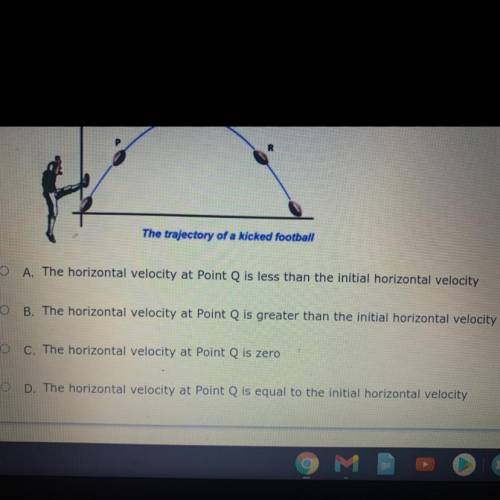
Physics, 16.11.2020 01:00 jordan2875
Physics students were asked about the horizontal velocity at Point Q in the football's trajectory. Ignoring air resistance, which is the best description of the horizontal velocity of the football at Point Q?


Answers: 3


Other questions on the subject: Physics

Physics, 22.06.2019 03:30, itsRyanPlayzMC9660
Scout feels ill one day before school. her mother puts a thermometer in her mouth and the temperature begins to climb to 100°f. what is happening between the cooler thermometer and scout's body? a) scout's body is applying a force to the particles in the thermometer. b) kinetic energy is being transferred from her mouth to the thermometer. c) potential energy is being lost by the thermometer and gained by scout's body. d) the potential energy stored in foods is converted to mechanical energy to raise the mercury in the thermometer.
Answers: 1

Physics, 22.06.2019 03:40, AkramMasoud
Which types of electromagnetic waves have higher frequencies than the waves that make up ultraviolet light? check all that apply. radio waves infrared light microwaves gamma rays visible light x-rays
Answers: 2

Physics, 22.06.2019 08:00, jhanes1983
Ms. hidalgo opens the door to her classroom. her classroom is 60 degrees and the air outside is 80. predict what will happen using your knowledge of how heat flows.
Answers: 2

Physics, 22.06.2019 17:00, jenn8055
In the future, people will only enjoy one sport: electrodisc. in this sport, you gain points when you cause metallic discs hovering on a field to exchange charge. you are an electrodisc player playing the popular four disc variant. the disks have charges of qa = −8.0 µc, qb = −2.0 µc, qc = +5.0 µc, and qd = +12.0 µc. (1) you bring two disks together and then separate them. you measure the resulting charge of these two disks and find that it is +5.0 µc per disk. which two disks did you bring together? (a) a and b (b) a and c (c)a and d (d)b and c(e) b and d (f) c and d. (2) you bring three disks together and then separate them. you measure the resulting charge of these three disks and find that it is +3.0 µc per disk. which three disks did you bring together? a, b, and c (a) a, b, and d (c) a, c, and d (d) b, c, and d. (3) given the resulting charge of each disk measured in (b) is +3.0 µc, how many electrons would you need to add to a disk of this charge to electrically neutralize it? electrons
Answers: 3
You know the right answer?
Physics students were asked about the horizontal velocity at Point Q in the football's trajectory. I...
Questions in other subjects:

English, 11.02.2021 17:30


Mathematics, 11.02.2021 17:30

Social Studies, 11.02.2021 17:30




Mathematics, 11.02.2021 17:30




